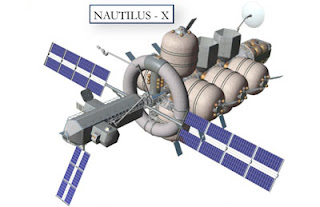Another Kind Of Shuttle Extension
To many advocates of extending the Space Shuttle, the most important thing is jobs. They'll tell you about how the crew at the United Space Alliance are doing such a fantastic job and it would be a shame to lose this national asset. Which is funny because, back in 2004 when the Shuttle retirement decision was made, we were told that the workforce is aging, retiring, and unable to get new blood.
However, a rare few who advocate Shuttle extension do so because they strongly appreciate the capability of the Shuttle, and cite Hubble servicing missions as the greatest demonstration of these. I, for one, think this capability can be better served by more cost effective means: building satellites so they are roboticly serviceable to begin with, or the robotic/manned options for Dragon presented by Max Vozoff in March.
But it is interesting to think about how one might utilize the orbiters once they retire. The current plans are to ship them to museums and stare at them in wonder.. that seems like a shame. Richard Godwin and Dennis Wingo have suggested that the orbiters could be "retired on-orbit". Maintaining their capability. They are undeterred by the long list of retrofits that would be required to make this workable, and maybe even a little naive, but I have to give them credit because they actually recognize the problems of the Shuttle's on-orbit endurance.
However, a rare few who advocate Shuttle extension do so because they strongly appreciate the capability of the Shuttle, and cite Hubble servicing missions as the greatest demonstration of these. I, for one, think this capability can be better served by more cost effective means: building satellites so they are roboticly serviceable to begin with, or the robotic/manned options for Dragon presented by Max Vozoff in March.
But it is interesting to think about how one might utilize the orbiters once they retire. The current plans are to ship them to museums and stare at them in wonder.. that seems like a shame. Richard Godwin and Dennis Wingo have suggested that the orbiters could be "retired on-orbit". Maintaining their capability. They are undeterred by the long list of retrofits that would be required to make this workable, and maybe even a little naive, but I have to give them credit because they actually recognize the problems of the Shuttle's on-orbit endurance.


I'd be curious how you think ANYTHING in work or proposed could match the Shuttles abilities? They have dominated human and cargo transport, and are the only thing fielded with anything remotely close to their capabilities. [At a cost much less then Ares-I\Orion alone.]
ReplyDeleteFurther its worth considering if you put the several billion [10+?] projected for commercial crew development and/or lifeboat Orion development, or the tens of billions for Ares\Orion or Constellation, into Shuttle upgrades; what its capabilities and affordability be?
The shuttle's capabilities are great.. for satellite servicing missions.. but there's other more cost effective ways to do it. I linked to one, go read it.
ReplyDeleteThe link wasn't accessible, and shuttles also good for assembling and launch platforms or ships far larget then any HLV could - as well as its big aset, it can bring big things down -- like for servicing back at the factory?
ReplyDeleteThe Shuttle has plenty of capability that has never been used, yes. But that's not a virtue.
ReplyDeleteStill, it does what nothing else on the horizon can do, and still isn’t up to the minimum you’d need to really do something in space. (Something past little research platforms etc. something seriously commercial.) And its more economical then "competing" systems. [Ok competing gets complicated on a gov bird operated to maximize pork.]
ReplyDeleteThat url should work now btw.
ReplyDeleteThanks for the URL -- probably moot given Dragons a no go for NASA crew - and I'm not at all clear how you'd get out of it in NASA space suits. Also wondering how many flights you'd need to do to equal a shuttle servicing mission.
ReplyDeleteMore interesting is how under commercial crew the per flight program costs will go up, possibly more then double, the shuttles per flight cost.